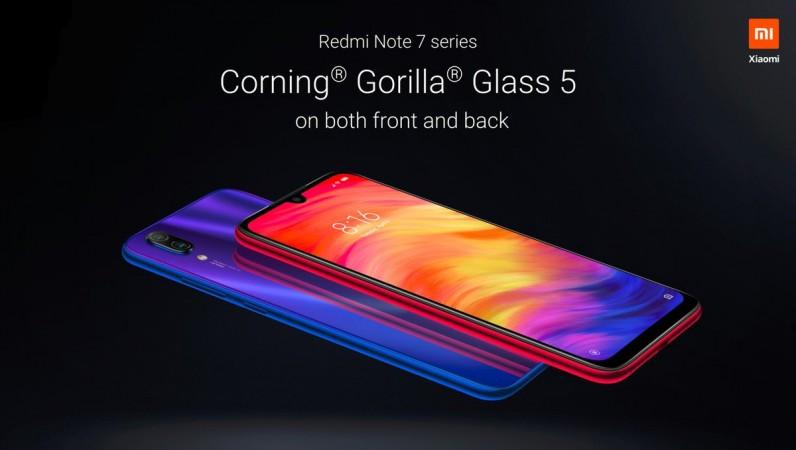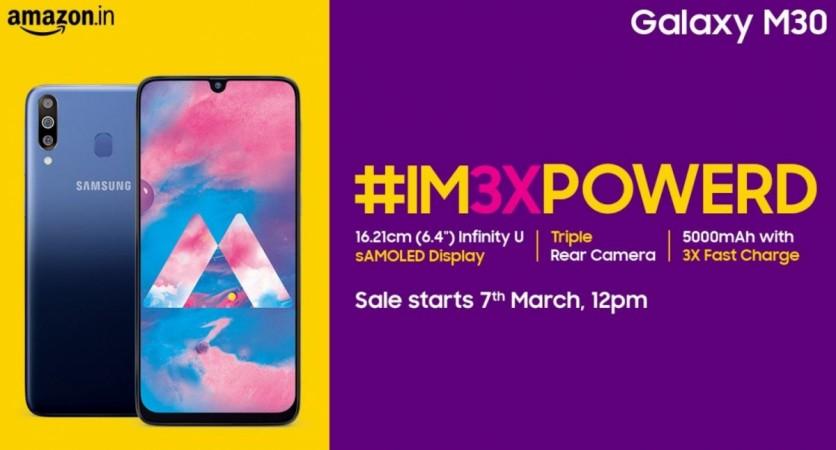The Indian smartphone market welcomed two new budget premium smartphones on Thursday, both competing against one another in a big way. Samsung and Xiaomi have been engaging in major battle to dominate the smartphone market in India and both companies launched their best smartphones to attract consumers.
The Redmi Note 7 Pro and Samsung Galaxy M30 are the latest entries in the sub-Rs 20,000 smartphone category. Since both phones offer value-for-money specs, it gets extremely difficult for end consumers to pick one smartphone. That said, a quick comparison of both phones can come in handy for buyers planning to upgrade to either smartphone.
Before we begin comparing the specs and features of Galaxy M30 and Redmi Note 7 Pro, here's how both phones are priced in India. Samsung Galaxy M30 comes in two variants 4GB RAM + 64GB storage and 6GB RAM + 128GB storage—for Rs 14,990 and Rs 17,990, respectively. The smartphones will go on sale exclusively on Amazon.in starting March 7.
Xiaomi Redmi Note 7 Pro also comes in two configurations, 4GB RAM + 64GB storage and 6GB RAM + 128GB storage— for Rs 13,999 and Rs 16,999, respectively. It is clear that the price difference between the two phones isn't much, making the decision of picking one smartphone harder.
Let's see how Samsung Galaxy M30 and Redmi Note 7 Pro fair against one another.
Design
Samsung usually has its signature design, but the Galaxy M30 is more inclined to take on its rival Redmi Note 7 Pro. For this reason, the Galaxy M30 looks a lot identical to the Xiaomi smartphone. From a gradient back to sleek bezels, a rear-mounted fingerprint sensor and a tiny notch, there's a lot of similarity between the two phones.
Both look great, but the different colour options can help you make your pick. Redmi Note 7 Pro comes in Neptune Blue, Nebula Red, and Space Black colours, while the Galaxy M30 has Gradation Black and Gradation Blue colour options.

Display
Once again, the similarities are uncanny. Samsung Galaxy M30 features a 6.4-inch Full HD+ Super AMOLED Infinity-U display, which is nothing but a water-drop style notch as seen on the Redmi Note 7 Pro as well. There's a slightly smaller 6.3-inch Full HD+ display on the Redmi Note 7 Pro. We bet the difference is unobtrusive.
Camera
This is where one smartphone trumps another. Samsung Galaxy M30 bags a triple camera setup at the back, which combines a 13MP RGB sensor with f/1.9 aperture, a 5MP f/2.2 depth sensor and a 5MP ultra-wide sensor with 123 degrees field of view and aperture of f/2.2. This is pitted against Redmi Note 7 Pro's dual rear cameras, which include a 48-megapixel primary sensor with f/1.79 aperture and a 5-megapixel secondary depth sensor.

On the front, Samsung Galaxy M30 sports a 16MP camera with Live Focus and the Redmi Note 7 Pro settles for a 13MP sensor.
So if you want to capture those beautiful landscapes without cropping out the edges, Samsung has got you covered. Xiaomi touts its camera features like AI scene detection, AI Portrait 2.0, and Night mode. We are yet to try our hands on both phones to compare the results, so stay tuned for the final verdict.
Performance
While RAM and storage configurations on both phones are the same, the processors are different. Samsung uses its own 14nm class 1.8 GHz Exynos 7904 octa-core processor in the Galaxy M30, while the Redmi Note 7 Pro is powered by Qualcomm Snapdragon 675 octa-core chipset. In both cases, the performance is likely to remain the same, but we'll test them out once we get our review units.

Battery
Under the hood, both phones have generous battery packs. But the Galaxy M30 once again takes the lead with its massive 5,000mAh battery that comes with 15W fast charger compared to Redmi Note 7 Pro's 4,000mAh battery with Quick Charge 4.0 support. Both phones have USB Type-C port for charging and data transfer.
Add-ons
Both phones have similar add-ons, including dual SIM support, expandable microSD card slot, rear-mounted fingerprint scanner, face unlock support, Wi-Fi, Bluetooth and other standard connectivity features. While the Redmi Note 7 Pro runs Android Pie-based MIUI 10 out-of-the-box, the Galaxy M30 comes with Android 8.1 Oreo-based Samsung Experience 9.5 UI. But Samsung promises to rollout Android Pie soon.
Verdict
While it's hard to give a final verdict just by looking at the specs, but from what we can understand, Samsung Galaxy M30 wins by an edge. Features like triple cameras, bigger battery and an interesting design really make up for the small price hike it is asking over the Redmi Note 7 Pro.

















